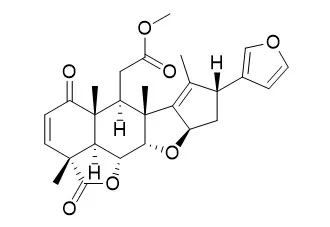| In vitro: |
| Cell Prolif. 2014 Dec;47(6):540-52. | | Nimbolide inhibits invasion and migration, and down-regulates uPAR chemokine gene expression, in two breast cancer cell lines.[Pubmed: 25377085] | Breast cancer is the most frequently diagnosed cancer and the leading cause of cancer death in women, worldwide. Urokinase type plasminogen activator (uPA) is a serine protease that is involved in cancer progression, especially invasion and metastasis of breast cancer. Nimbolide is a potent cytotoxic limnoid isolated from Azadirachta indica. Our previous studies have shown that Nimbolide elicits pleiotropic effects on breast cancer cells; however, its roles in invasion and migration have not previously been fully elucidated.
METHODS AND RESULTS:
Protein expression of pEGFR, VEGFR, NFκB, IKKα, IKKβ, MMP-2, MMP-9 and TIMP-2 were analysed by western blotting. We also analysed expressions of uPA, uPAR genes and chemokines by real-time PCR. Breast cancer cell invasion was assessed by transwell invasion assay and cell migration analysed by scratch wound healing assay. Our results showed that reduced protein expression of pEGFR, VEGFR, NFκB, IKKα, β, MMP-2, MMP-9 and TIMP-2 was higher in Nimbolide-treated breast cancer cells. mRNA expression of uPA, uPAR, chemokines and their receptors were also significantly reduced in response to Nimbolide treatment. Nimbolide inhibited breast cancer cell migration and invasion as shown in transwell invasion and wound healing assays.
CONCLUSIONS:
These results clearly proved inhibitory effects of Nimbolide on tumour cell invasion and migration by down-regulating proteins critically involved in regulation of cell invasion and metastasis, suggesting a possible therapeutic role of Nimbolide for breast cancer. | | International Journal of Pharmacy & Pharmaceutical Sciences, 2014, 6(5):636-638. | | Antibacterial potential of Nimbolide from Azadirachta indica[Reference: WebLink] |
The present study was designed to evaluate the antibacterial activity of the isolated Nimbolide compound from Azadirachta indica.
METHODS AND RESULTS:
Antibacterial potential of the isolated Nimbolide compound of Azadirachta indica plants was screened by disc diffusion assay against Bacillus subtilis, Enterococcus faecalis, Streptococcus epidermis, Enterobacter aerogene, Enterobacter cloacae, and Salmonella typhimurium. Ciprofloxacin is used as standards for bacteria. Minimum inhibitory concentration (MIC) and minimum bactericidal concentration (MBC) of Nimbolide compound was determined using the macro dilution method. The antibacterial potency of Nimbolide compound from Azadirachta indica was assessed by their zone of inhibition values. Nimbolide showed satisfactory results against almost all the organisms, among them against Salmonella typhimurium and Bacillus subtilis showed highest zone of inhibition 18.1 mm and 17.3 mm (0.4mg/ml) with the MIC values of 0.078 mg/ml and MBC values of 0.156 mg/ml. Other pathogens like Streptococcus epidermis, Enterococcus faecalis showed good zone of inhibition 13.2 mm and 11.8 mm (0.4mg/ml). But Enterobacter cloacae was found to be resistant with more MIC, more MBC value and with a very less zone of inhibition of 8.5 mm (0.4mg/ml) when compared with the standards (Ciprofloxacin).
CONCLUSIONS:
The present investigations revealed that Nimbolide have significant antibacterial activity. So, the potent antibacterial agent Nimbolide is preferred for infectious disease. |
|
| In vivo: |
| Invest New Drugs. 2010 Aug;28(4):392-401. | | The neem limonoids azadirachtin and nimbolide inhibit cell proliferation and induce apoptosis in an animal model of oral oncogenesis.[Pubmed: 19458912] | Limonoids from the neem tree (Azadirachta indica) have attracted considerable research attention for their cytotoxicity against human cancer cell lines. However, the antiproliferative and apoptosis inducing effects of neem limonoids have not been tested in animal tumour models.
METHODS AND RESULTS:
The present study was therefore designed to evaluate the relative chemopreventive potential of the neem limonoids azadirachtin and Nimbolide in the hamster buccal pouch (HBP) carcinogenesis model by analyzing the expression of proliferating cell nuclear antigen (PCNA), p21(waf1), cyclin D1, glutathione S-transferase pi (GST-P), NF-kappaB, inhibitor of kappaB (IkappaB), p53, Fas, Bcl-2, Bax, Bid, Apaf-1, cytochrome C, survivin, caspases-3, -6, -8 and -9, and poly(ADP-ribose) polymerase (PARP) by RT-PCR, immunohistochemical, and Western blot analyses.
CONCLUSIONS:
The results provide compelling evidence that azadirachtin and Nimbolide mediate their antiproliferative effects by downregulating proteins involved in cell cycle progression and transduce apoptosis by both the intrinsic and extrinsic pathways.
On a comparative basis, Nimbolide was found to be a more potent antiproliferative and apoptosis inducing agent and offers promise as a candidate agent in multitargeted prevention and treatment of cancer. |
|






 Cell. 2018 Jan 11;172(1-2):249-261.e12. doi: 10.1016/j.cell.2017.12.019.IF=36.216(2019)
Cell. 2018 Jan 11;172(1-2):249-261.e12. doi: 10.1016/j.cell.2017.12.019.IF=36.216(2019) Cell Metab. 2020 Mar 3;31(3):534-548.e5. doi: 10.1016/j.cmet.2020.01.002.IF=22.415(2019)
Cell Metab. 2020 Mar 3;31(3):534-548.e5. doi: 10.1016/j.cmet.2020.01.002.IF=22.415(2019) Mol Cell. 2017 Nov 16;68(4):673-685.e6. doi: 10.1016/j.molcel.2017.10.022.IF=14.548(2019)
Mol Cell. 2017 Nov 16;68(4):673-685.e6. doi: 10.1016/j.molcel.2017.10.022.IF=14.548(2019)